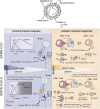Will SARS-CoV-2 Infection Elicit Long-Lasting Protective or Sterilising Immunity? Implications for Vaccine Strategies (2020)
- PMID: 33362759
- PMCID: PMC7756008
- DOI: 10.3389/fimmu.2020.571481
Will SARS-CoV-2 Infection Elicit Long-Lasting Protective or Sterilising Immunity? Implications for Vaccine Strategies (2020)
Abstract
In December 2019, an outbreak of a novel coronavirus (SARS-CoV-2) in Wuhan, China resulted in the current COVID-19 global pandemic. The human immune system has not previously encountered this virus, raising the important question as to whether or not protective immunity is generated by infection. Growing evidence suggests that protective immunity can indeed be acquired post-infection-although a handful of reinfection cases have been reported. However, it is still unknown whether the immune response to SARS-CoV-2 leads to some degree of long-lasting protection against the disease or the infection. This review draws insights from previous knowledge regarding the nature and longevity of immunity to the related virus, SARS-CoV, to fill the gaps in our understanding of the immune response to SARS-CoV-2. Deciphering the immunological characteristics that give rise to protective immunity against SARS-CoV-2 is critical to guiding vaccine development and also predicting the course of the pandemic. Here we discuss the recent evidence that characterises the adaptive immune response against SARS-CoV-2 and its potential implications for the generation of memory responses and long-term protection.
Keywords: COVID-19; SARS-CoV-2; immunity; immunogenicity; protective; vaccine.
Copyright © 2020 Kim, Rowland-Jones and Gea-Mallorquí.
Conflict of interest statement
The authors declare that the research was conducted in the absence of any commercial or financial relationships that could be construed as a potential conflict of interest.
Figures
References
Publication types
MeSH terms
Substances
LinkOut - more resources
Full Text Sources
Miscellaneous


